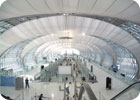Hot Tech at New Bangkok Airport

IP cameras, sophisticated command and control, explosives detection and two comm. Pipelines are among security features at the soon-to-open Suvarnabhumi International Airport. Pictured is the terminal – the world’s largest.
A golf course is not in the cards for a new international airport serving Thailand. Suvarnabhumi International Airport, under construction for half a decade, will replace Bangkok International Airport (BIA). It’s expected to open later this year.
The spanking-new Suvarnabhumi will boast some of the most advanced electronic security systems and explosives detection gear compared to BAI, which boasts a golf course between its two runways and blinking red lights to warn the duffers.
The new airport, located on a boggy site called Cobra Swamp (possibly low-tech security there), will handle 30 million passengers per year when it first opens.
The passenger terminal complex (comprising the terminal itself as well as the concourse) covers an area of 182,000 square meters. Seven floors and a basement will give the terminal a total floor area of over 500,000 square meters, the largest in the world. Suvanabhumi will have one of the tallest control tower complexes in the world at 132 meters with 2,600 square meters of utility space.
Two pipelines
A fiber optics communication network is the main “inside the airport” communications pipeline while communications with public networks will be made through a digital data network. All handle voice, data and video.Security’s also a big deal.
There are nearly 30 CTX 9000 explosive detection baggage scanning devices and their accessories already installed under a $65 million contract.
A solution from DVTel (Ridgefield Park, N.J.) will provide command and control for the world’s largest airport terminal. Thailand Aviation officials completed the test phase for Suvarnabhumi late last year.
DVTel technical staff and partners were also in attendance to fully test the system as part of that “soft launch” proceedings. Johnny Trivitayakhun, managing director for Semple Cochrane (Asia), overseeing this part of the project, said, “The system passed with flying colors, and now with the recent installation of DVTel-brand cameras, this is one of the most advanced, integrated surveillance airport systems in the world.”
At present, upwards to 600 PTZ and fixed IP dome cameras have been installed in the passenger terminal and concourse buildings, the short-term car park buildings, baggage inspection rooms and baggage conveyor areas. An iSOC platform, with the Network Video Management System at its core, provides IP network video surveillance and serves as the management software for what will eventually number thousands of surveillance cameras located throughout the passenger terminals. As the command and control center, the iSOC accesses and correlates data from multiple systems like facial recognition, access control, fire alarms, building automation and other data sources. Video will be available at command centers and on designated desktops, but also via wireless to officials’ hand-held devices anywhere in the airport complex.
Looking for a reprint of this article?
From high-res PDFs to custom plaques, order your copy today!





